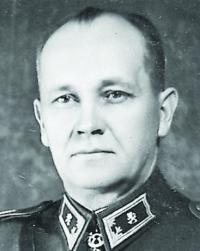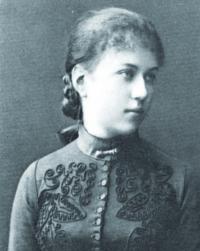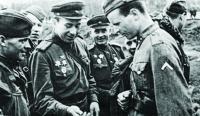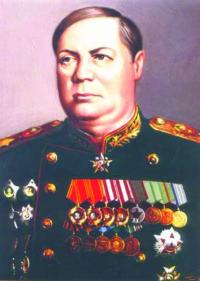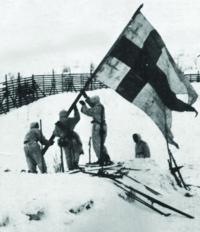THIS WEEK, 70 years ago, Finland followed the precedent set by the Kingdoms of Italy and Romania, by executing an armistice with the United Kingdom and the U.S.S.R., and beginning military operations against its erstwhile German ally. (The U.S. and Finland were not at war.)
In the late 1930s, the Soviet Union was concerned with its security and felt that war with the resurgent German Reich was inevitable. It was concerned with Finland’s ties with Germany, since it was only with German help that Finland had secured its independence from Russia. Germany was fostering good relations with all Scandinavian Countries so that it would have ready access to Scandinavian raw materials. In addition to the proximity of the Finnish border to the Soviet Union’s second city, Leningrad, there was the danger perceived by the Soviet government of the exposure of its Naval Base at Kronstadt, in the Gulf of Finland, which was home to the Soviet Baltic fleet.
In October 1939, negotiations began in earnest. Ultimately, the Finns, ignoring the advice of their army commander, Field Marshal Baron Karl Gustav Mannerheim, to cut the best deal possible, declined the Soviet offer. The Soviet Commissar for Foreign Affairs, Vyacheslav Mikhailovich Molotov, noted that, “Since we civilians can’t achieve anything, the matter has to be left to the military personnel.”
On November 30, 1940, 465,000 Soviet soldiers, supported by 1000 planes, under the command of Kirill Meretskov, attacked Finland on an 800-mile front. The Finnish defenders numbered 165,000 and were supported by 150 outdated planes. However, the Red Army was not properly prepared, properly led, properly equipped or properly trained to meet the plucky Finns on their home turf. It received a very bloody nose. The Finnish attitude was expressed by the enquiry, “There are so many, and our country is so small, where will we find the room to bury them all?”
Eventually sheer weight of numbers prevailed, and on March 12, an armistice was executed. The Soviet Union took 10 percent of Finnish territory - far more than they had requested originally - including the city of Viipuri, Finland’s second largest. Today, it is the Russian city of Vyborg, with a population of 90,000. More than 400,000 Finnish citizens were evacuated from the areas ceded to the U.S.S.R. This action was called, “The Winter War.”
After the Axis launched Operation Barbarossa, the Finns saw an opportunity to recover the lost territory and joined in the assault on the beleaguered Soviet Union. At a meeting of the Finnish Parliament, on June 25, 1941, Prime Minister Johan Wilhelm Rangell announced that a “Continuation War” existed between the Republic of Finland and the U.S.S.R. This would be a “Continuation” of the “Winter War” between the two countries. Finnish President Rysto Ryti declared that this time, “...we are not alone. Germany has decided to wage war against the Soviet Union, and other nations have joined it. The U.S.S.R. is facing a united front from the White Sea to the Black Sea.”
Everyone thought that the Soviets would be defeated in a few weeks, and when it didn’t happen that quickly, the Finns began thinking that maybe they didn’t want to go “all in.” And even though they didn’t, Great Britain gave them an ultimatum to withdraw to the pre-Winter War borders, and when they didn’t, the British and the Commonwealth countries declared war on Finland, in December 1941. The U.S. did not follow suit. Although they did occupy more territory than was taken from them in the Winter War, they did not (1) advance on Leningrad from the north; nor (2) make a serious attempt to take the ports of Murmansk or Arkhangelsk. The fall of either of those cities would have been devastating to the Soviet effort.
Following Axis’ reverses at, first, Stalingrad, and then Kursk, the Finns began to see the writing on the wall and like Hungary’s Regent, Admiral Miklos Horthy, began to look for a way out.
More than 600 Soviet bombers attacked the Finnish capital on the night of February 26, 1944. The fires could be seen for several hundred miles. Only three planes were lost. Armistice talks were soon begun. A Finnish diplomat arrived in Stockholm and met with the Soviet ambassador to Sweden, Aleksandra Mikhaylovna Kollontay, to open talks to extricate Finland from the war. The Soviets responded with terms which the Finns considered too harsh.
On June 10, 1944, General Leonad A. Govorov’s Leningrad Front assaulted Viipuri, which fell 11 days later. Govorov was named a Marshal of the Soviet Union eight days after the assault on Viipuri began. On March 25, 2010, the city was accorded the title “City of Military Glory,” by Russian President Dmitriy Medvedev.
The day of Viipuri’s capture, General Meretskov’s Karelian Front, launched an offensive north of Lake Ladoga. Again the Finns asked for terms. The Soviet Union responded by demanding unconditional surrender, which was rejected.
The Karelian Front’s 32nd Army, commanded by Lt. Gen. Filipp Danilovich Gorelenko, launched an offensive in North Karelia on July 26, 1944. In the two-week Battle of Ilomantsi, the outnumbered Finns, under the command of Maj. Gen. Erkki Raappana, stopped the Soviet advance, destroyed two, of the four, Soviet Rifle Divisions and captured more than 100 pieces of heavy artillery and 100 mortars.
Although the Red Army had been stopped, and mauled, the Finns knew that once the Soviets got serious, they could probably only hold for three months. And the Soviets knew that there was still plenty of fight left in the Finns. So, when the Soviets softened their demands, a bit, an armistice was signed, on September 5, 1944, ending the fighting between the two. A second armistice - the “Moscow Armistice” - was signed on September 19, 1944.
By that time, Romania and Bulgaria had capitulated and switched sides. Their armies were now fighting alongside the Red Army, against their erstwhile German and Hungarian allies.
The Continuation War cost the Finns 58,000 dead, while 26,000 had died in the Winter War, from a population of 4,000,000. Percentage-wise, the losses the Finns suffered was seven (7) times that of the United States.
Because they had not advanced “too far,” and had fought well, Stalin allowed the nation its postwar independence - but, on a tight leash. It lost more territory, including the nickel-rich area around Petsamo, access to the Arctic Ocean and was required to try President Ryti, and other politicians for war crimes. It would declare war on its erstwhile ally on March 3, 1945, two months before Germany’s unconditional surrender. Prior to that, it had hustled the Wehrmacht out of Finland, at a cost of another 4,200 casualties, in the “Lapland War,” fought mostly in the north.
NEXT WEEK: THE V-2 ROCKET ASSAULT ON ENGLAND
Mr. Wimbrow writes from Ocean City, Maryland, where he practices law representing those persons accused of criminal and traffic offenses, and those persons who have suffered a personal injury through no fault of their own. Mr. Wimbrow can be contacted at
wimbrowlaw@gmail.com.


